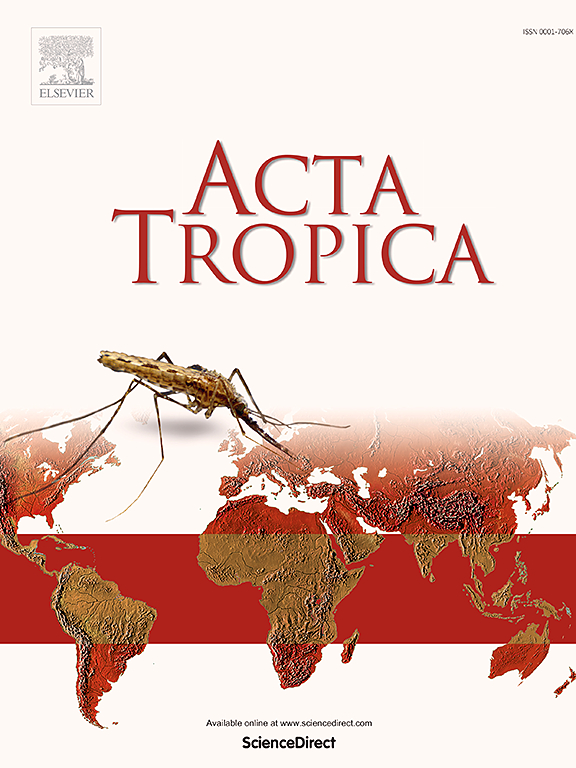澳大利亚热带地区立克次体病的呼吸道表现临床过程和对病人管理的影响
IF 2.1
3区 医学
Q2 PARASITOLOGY
引用次数: 0
摘要
立克次氏体感染具有全球性分布,可导致危及生命的疾病。呼吸道症状可能预示着更复杂的病程。然而,立克次体病和呼吸系统受累患者的临床关联和临床病程尚未完全确定。方法回顾性研究1997年1月1日至2023年10月31日在澳大利亚热带地区凯恩斯医院诊断为恙虫病或昆士兰蜱虫斑疹伤寒(QTT)的所有患者。我们确定了呼吸受累的人口学、临床、放射学和实验室关联,呼吸受累被定义为住院期间胸部影像学发现的肺实质急性异常,没有其他更可能的解释。我们比较了立克次体感染患者的临床病程,这些患者有和没有呼吸系统受累。结果共纳入226例患者,51/226例(22%)存在呼吸道感染,其中恙虫病18/59例(31%)、恙虫病33/167例(20%),p = 0.09。影像学表现不均匀:33/51(65%)主要为肺泡改变,18/51(35%)为间质改变,12/51(24%)为胸腔积液。呼吸受累的患者比无呼吸受累的患者年龄大(中位数(四分位间距(IQR)),分别为51(37-65)岁和38(25-51)岁(p = 0.0001)。然而,大多数呼吸受累患者(27/51,53%)没有合并症,年龄小于60岁。有呼吸受累的患者比无呼吸受累的患者更有可能需要ICU住院(19/51 (38%)vs 6/175 (3%)) p <;0.001)和9/51(18%)的呼吸受累患者需要机械通气。呼吸受累的患者也更有可能需要血管加压素支持(14/ 51,27 %对4/ 175,2 %,p <;0.001)和肾脏替代治疗(4/ 51,8 %对1/ 175,0.6 %,p = 0.01)比无呼吸受累的患者。在研究期间,2/226(1%)的人死于立克次体感染(1例恙虫病和1例QTT),均有呼吸道受累。结论:在澳大利亚热带地区的立克次体感染患者中,呼吸道受累是常见的,并且与危及生命的疾病的更高风险相关。本文章由计算机程序翻译,如有差异,请以英文原文为准。

Respiratory manifestations of rickettsial disease in tropical Australia; Clinical course and implications for patient management
Background
Rickettsial infections have a global distribution and can cause life-threatening disease. Respiratory symptoms can be a harbinger of a more complicated disease course. However, the clinical associations – and the clinical course – of patients with rickettsial disease and respiratory involvement are incompletely defined.
Methods
This was a retrospective study of all patients with a diagnosis of scrub typhus or Queensland tick typhus (QTT) managed at Cairns Hospital in tropical Australia, between 1st January 1997 and 31st October 2023. We determined the demographic, clinical, radiological and laboratory associations of respiratory involvement which was defined as any acute abnormality of lung parenchyma identified on thoracic imaging during their hospitalisation that did not have another more likely explanation. We compared the clinical course of patients with a rickettsial infection who did – and did not – have respiratory involvement.
Results
There were 226 individuals included in the analysis, 51/226 (22 %) had respiratory involvement, including 18/59 (31 %) with QTT and 33/167 (20 %) with scrub typhus, p = 0.09. The imaging findings were heterogenous: 33/51 (65 %) had predominantly alveolar changes, 18/51 (35 %) had interstitial changes and 12/51 (24 %) had a pleural effusion. Those with respiratory involvement were older than individuals without respiratory involvement (median (interquartile range (IQR)) age 51 (37–65) years versus 38 (25–51) years (p = 0.0001). However, most patients (27/51, 53 %) with respiratory involvement had no comorbidity and were younger than 60. Patients with respiratory involvement were more likely to require ICU admission that patients without respiratory involvement (19/51 (38 %) versus 6/175 (3 %) p < 0.001) and 9/51 (18 %) with respiratory involvement required mechanical ventilation. Patients with respiratory involvement were also more likely to require vasopressor support (14/51, 27 % versus 4/175, 2 %, p < 0.001) and renal replacement therapy (4/51, 8 % versus 1/175, 0.6 %, p = 0.01) than patients without respiratory involvement. There were 2/226 (1 %) individuals who died from their rickettsial infection (1 scrub typhus and 1 QTT) during the study period, both had respiratory involvement.
Conclusions
Respiratory involvement is common in individuals with rickettsial infection in tropical Australia and is associated with a greater risk of life-threatening disease.
求助全文
通过发布文献求助,成功后即可免费获取论文全文。
去求助
来源期刊

Acta tropica
医学-寄生虫学
CiteScore
5.40
自引率
11.10%
发文量
383
审稿时长
37 days
期刊介绍:
Acta Tropica, is an international journal on infectious diseases that covers public health sciences and biomedical research with particular emphasis on topics relevant to human and animal health in the tropics and the subtropics.
 求助内容:
求助内容: 应助结果提醒方式:
应助结果提醒方式:


